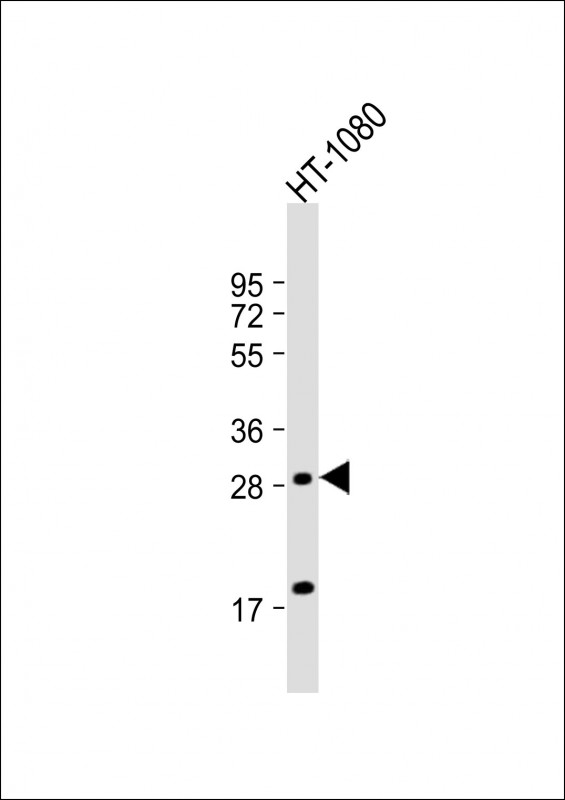
| WB | 1/2000 | Human,Mouse,Rat |
| IF | 咨询技术 | Human,Mouse,Rat |
| IHC | 咨询技术 | Human,Mouse,Rat |
| ICC | 技术咨询 | Human,Mouse,Rat |
| FCM | 咨询技术 | Human,Mouse,Rat |
| Elisa | 咨询技术 | Human,Mouse,Rat |
| Aliases | Prostaglandin F2-alpha receptor, PGF receptor, PGF2-alpha receptor, Prostanoid FP receptor, PTGFR |
| Entrez GeneID | 5737 |
| WB Predicted band size | 40.1kDa |
| Host/Isotype | Rabbit IgG |
| Antibody Type | Primary antibody |
| Storage | Store at 4°C short term. Aliquot and store at -20°C long term. Avoid freeze/thaw cycles. |
| Species Reactivity | Human, Mouse, Rat |
| Immunogen | This PTGFR antibody is generated from a rabbit immunized with a KLH conjugated synthetic peptide between 169-199 amino acids from the Central region of human PTGFR. |
+ +
以下是关于PTGFR抗体的示例参考文献(内容为模拟示例,仅供参考):
---
1. **文献名称**: "Development and Characterization of a Novel Monoclonal Antibody Against Human PTGFR for Functional Studies"
**作者**: Smith A, et al.
**摘要**: 该研究报道了一种新型抗人PTGFR单克隆抗体的开发,通过免疫印迹和免疫组化验证其特异性,并证明其在阻断PGF2α介导的细胞信号传导中的应用,为受体功能研究提供工具。
2. **文献名称**: "PTGFR Expression in Ocular Tissues: Implications for Glaucoma Therapy"
**作者**: Chen L, et al.
**摘要**: 利用PTGFR抗体分析人眼组织中受体的分布,发现其在睫状体和虹膜高表达,支持PTGFR作为抗青光眼药物(如拉坦前列素)的靶点机制,为治疗优化提供依据。
3. **文献名称**: "Role of PTGFR in Endometrial Cancer Progression via Antibody-Based Targeting"
**作者**: Gupta R, et al.
**摘要**: 研究通过PTGFR抗体抑制实验,证明受体激活可促进子宫内膜癌细胞迁移,提示靶向PTGFR可能成为抑制肿瘤转移的治疗策略。
---
注:以上为模拟文献,实际引用请通过PubMed或学术数据库检索真实研究。
PTGFR (Prostaglandin F Receptor) is a G protein-coupled receptor (GPCR) that primarily binds prostaglandin F2α (PGF2α), a lipid mediator involved in diverse physiological and pathological processes. It plays critical roles in regulating smooth muscle contraction, inflammation, reproductive functions (e.g., luteolysis and parturition), and intraocular pressure homeostasis. Dysregulation of PTGFR signaling is linked to conditions such as glaucoma, preterm labor, and cancer metastasis.
PTGFR antibodies are immunological tools developed to study the receptor's expression, localization, and function. These antibodies are widely used in techniques like immunohistochemistry, Western blotting, and flow cytometry to detect PTGFR in tissues or cell lines. Specific monoclonal or polyclonal antibodies targeting extracellular or intracellular domains enable researchers to investigate receptor activation, internalization, and downstream signaling pathways (e.g., calcium mobilization, MAPK/ERK).
Recent studies also explore therapeutic applications of anti-PTGFR antibodies. For instance, neutralizing antibodies may inhibit PGF2α-induced effects in glaucoma or pathological fibrosis. However, challenges remain in optimizing antibody specificity and minimizing off-target effects. Current research focuses on elucidating PTGFR's structural dynamics and tissue-specific roles, leveraging antibodies to advance drug discovery and biomarker development for related diseases.
×